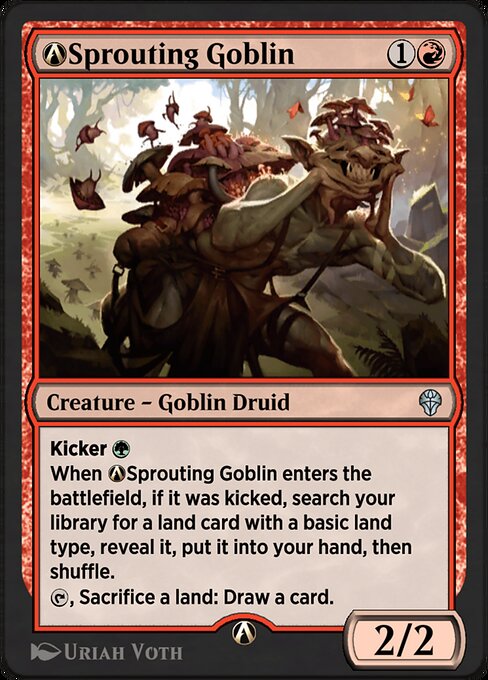
Image courtesy of Scryfall.com
Two Modes, One Goblin: Decoding the Kick and the Draw
In the Dominaria United era, A-Sprouting Goblin stands as a vivid example of how a few well-chosen keywords can bend the flow of a game. With a mana cost of {1}{R} and a kicker that can bend green into the mix, this little goblin embodies a compact rouge-and-ramp philosophy that reds and greens often flirt with on the battlefield. The creature itself is a nimble 2/2 for two mana, but it’s the aura of the kicker and the two-part ETB/draw loop that elevates it from "just another goblin" to a tool you plan around. 🧙♂️🔥💎
Kicker: The Extra Cost That Multiplies Options
The word “Kicker” might be familiar to most MTG players, and A-Sprouting Goblin wears the mechanic like a badge. You may pay an additional {G} as you cast this spell. That single extra green mana unlocks a pivotal line when the creature enters the battlefield: “When Sprouting Goblin enters, if it was kicked, search your library for a land card with a basic land type, reveal it, put it into your hand, then shuffle.” This twist on the usual ETB rhythm gives you a choice and a tempo swing—the board presence plus a guaranteed fetch if you lean into the green splash. It’s a delightful reminder that kicker isn’t just a discount; it’s predictive planning: did you allocate enough green to unlock a higher upside? And yes, the synergy feels especially tasty in Gruul-adjacent decks, where every land drop can feel like a small victory. 🧙♂️⚔️
Enter the Battlefield: ETB Triggers and Land Fetches
When a card says “enters the battlefield” with a conditional kicker attached, players tend to weigh risk and reward. A-Sprouting Goblin’s ETB trigger is a quintessential example: if you kicked, you get to tutor for a basic land and add it to your hand. In practical terms, this can accelerate your mana ramp, enabling quicker plays on the following turns or setting up a land drop that keeps your curve on track. The fetch is limited to a basic land type, which means a lot of strategic decisions about color fixing and mana base come into play. It’s not a free lunch, but it’s a very clean payoff for investing the extra green—your deck can lean into early pressure and late-game consistency at the same time. The art and flavor here blend nicely with Dominaria United’s nostalgia-forward vibe, where old tricks get new life with modern design constraints. 🎨🧙♂️
Activated Draw: Sacrifice a Land to Draw a Card
After the initial joyride of the ETB fetch, A-Sprouting Goblin keeps the momentum with a second, more self-contained ability: "{T}, Sacrifice a land: Draw a card." This line is a masterclass in tempo management. Sacrificing one of your lands to draw a card can be a calculated risk: you’re trading immediate land resources for card advantage. In land-heavy strategies, this can be a leap forward toward card parity or engine development, especially when you’re playing aggressiveRed-Green shells that want to apply pressure while keeping hand size healthy. It also echoes the evergreen tension between resource denial and value generation—do you cling to the land you have, or do you invest to fuel your next two or three turns? The dual nature of this card’s abilities invites a thoughtful, layered playstyle. 🧙♂️🎲
Color Identity and Deckbuilding Harmony
Although the card’s mana cost leans red, the kicker adds green, granting A-Sprouting Goblin a red-green color identity that’s ripe for hybrid strategies. The hybrid identity isn’t merely cosmetic here; it informs deck construction: you’ll want enough green sources to reliably activate the kicker, while maintaining enough red pressure to justify the approximate two-mana baseline. The synergy between land fetch on entry and land-sac draw later creates a rhythm—early tempo with a mid-to-late-game engine. It’s the kind of dual-natured design that reminds players why mixed-color builds endure in a single-card format. And while A-Sprouting Goblin shines in Arena—Dominaria United’s digital ecosystem—the fundamentals translate across formats, from casual kitchen-table play to more curated deck-building experiments. 🧙♂️💎
Practical Play: Where and How to Use A-Sprouting Goblin
In a world crowded with efficient two-drop creatures, A-Sprouting Goblin’s real strength is how its kicker and two-phase text create optionality. If you anticipate a land-drop-heavy early game, kicking the spell can yield a deeper hand advantage, especially if you’re in a deck that wants to accelerate into domain-crunchy midgame plays. In a more aggressive setup, the Goblin can still contribute a resilient 2/2 body while offering a protective, optional fetch when you’re ready to pivot to a ramp-heavy plan. In Arena, the card’s rebalanced nuances and digital-friendly timing options let you experiment with different lines of play, testing how often the kicked route pays off. The lore-lite flavor aligns with the goblin-druid vibe—an unlikely cross between goblin mischief and forest-crafting that feels earned, not forced. 🧙♂️🔥🎨
- Pair with land-heavy strategies that benefit from rapid land payments and reliable fetches.
- Consider Gruul or Naya-ish shells where red aggression meets green ramp for a two-pronged approach.
- Balance your hand with the draw ability so you don’t overspend on land sacrifices when you’re not ahead on the board.
For players who love to chase synergy between keywords and spells, A-Sprouting Goblin offers a neat microcosm of design: a modest body, a dual-path ability suite, and a flavor that nods to the way magic can sprout from the ground up—literally. If you’re curious to explore more about comparative keyword abilities or how similar constructs show up across sets, you can keep an eye on the broader Dominaria United landscape and its ongoing conversations about how old-school mechanics meet contemporary balance. 🧙♂️🧭